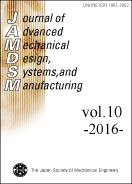
- |<
- <
- 1
- >
- >|
-
Teruaki ITO2016 Volume 10 Issue 7 Pages JAMDSM0091
Published: 2016
Released on J-STAGE: October 31, 2016
JOURNAL FREE ACCESSDownload PDF (614K)
-
Hitoshi KOMOTO, Shinsuke KONDOH, Keijiro MASUI2016 Volume 10 Issue 7 Pages JAMDSM0092
Published: 2016
Released on J-STAGE: October 31, 2016
JOURNAL FREE ACCESSIn model-based product development, engineering models representing specific parts a product from diverse aspects and resolutions are used to reduce cost and lead time while systematically reducing design alternatives. Designers in the product development processes will benefit from these models if they are timely available. In order to utilize these models collected from past development processes, we propose a product development process simulation method, which computationally supports planning of the current product development process. In the proposed method, these models are used to identify the types of design tasks and dynamically instantiate them so that they can satisfy given product specifications. The method is integrated with estimation of the degree of progress in product development by using a set-based approach. The simulation procedure performs iterative updates of the degree of progress with a traversal search on the graph, which is made by extracting the attributes and their relations defined in these models, and connecting these models at the attributes in common. The use of the proposed method is illustrated through its application to the development of a wind turbine.
View full abstractDownload PDF (3246K) -
Toshitake TATENO, Yuta YAGUCHI, Masayuki FUJITSUKA2016 Volume 10 Issue 7 Pages JAMDSM0093
Published: 2016
Released on J-STAGE: October 31, 2016
JOURNAL FREE ACCESSThis paper deals with a fabrication method in additive manufacturing (AM). Generally, a large model must be segmented into some parts featuring connector shapes in case that its size is over the fabrication area of AM device. However, the connector portion of each segment is usually the weakest portion in strength because it becomes thinner or narrower than the original shape. In this study, the connector design and fabrication method is investigated in consideration of the strength depending on the deposition direction in AM. Since the most parts fabricated by AM with plastic materials have anisotropic property in strength, the strength of the part can be designed by the build orientation in AM. In this paper, after the concept of the parallel fabrication that is the basis of the segmentation planning is introduced, the anisotropy of strength is evaluated with tensile and fracture tests. Then, the factor of fracturing is discussed by using stress simulation with the finite element method. Finally, the appropriate connector design is proposed and the effectivity is discussed.
View full abstractDownload PDF (6535K) -
Anuar MOHAMED KASSIM, Takashi YASUNO, Hiroshi SUZUKI, Mohd SHAHRIEEL M ...2016 Volume 10 Issue 7 Pages JAMDSM0094
Published: 2016
Released on J-STAGE: October 31, 2016
JOURNAL FREE ACCESSIn this paper, the design and implementation of a spectacle based obstacle detection system is described. The usage of spectacle based obstacle detection system would help the visually impaired person to scan the surrounding especially at the upper body level from having head level collision. Four pieces of distance measurement sensors is proposed in the travel aid in order to detect the obstacle in each direction including front, down, left and right. If the distance measurement sensor detects an obstacle, the warning system will be activated and a warning signal on the location of the obstacle will be given to the user. The warning devices designed and implemented in the system are audio and vibration warning system. The usage of both warning devices can be switched on either as a single headphone audio or a vibration warning device depending on users' preference and environment. For example, if the user is joining a crowded environment such as market or bus terminal, they are recommended to change and use only the vibration warning device, whereby their stereo hearing sense will be used to capture the sound around them. An evaluation on the developed electronic spectacle was also done in order to produce an effective, reliable and light wearable device.
View full abstractDownload PDF (5782K) -
Taufik RONI SAHRONI, Li Ying LAU, Teruaki ITO2016 Volume 10 Issue 7 Pages JAMDSM0095
Published: 2016
Released on J-STAGE: October 31, 2016
JOURNAL FREE ACCESSThis paper presents the design of welded joint based on transient thermal condition. Resistance spot welding is a fast, easily automated and easily maintained process with high productivity. This paper was performed to investigate the design parameters of sheet metal welded joint based on transient thermal condition. The transient thermal condition of the sheet metal was analyzed and the factor of safety was proposed at the end of the project. The design parameters included were the number of spot welding, dimension, material and thickness of sheet metal. Aluminum 5182-H19 was used as a base material to study the mechanical properties and thermal behavior. The transient thermal analysis was conducted on aluminum alloy 5182-H19 sheet metal with dimension 120mm×60mm, thickness 1mm to 6mm and number of spot weld two to five. Suitable combination of thickness of sheet metal with number of spot weld is proposed after the simulation and analysis. The CAD model and analysis of sheet metal was performed by using ANSYS software. The results of both the thermal analysis were heat flux, reaction probe and factor of safety. Scoring concept was provided to determine the number of spot weld for each thickness of the sheet metal. It is found that two number of spot weld was suitable for thickness of 1mm, 2mm, 4mm, and 6mm. As a result, sheet metal with thickness 3mm and 5mm, five and two spot weld was suitable respectively.
View full abstractDownload PDF (2360K)
- |<
- <
- 1
- >
- >|